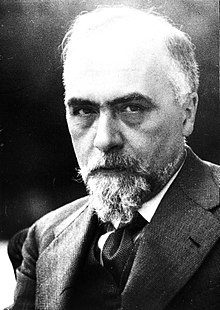Robert Danis
Robert Danis (born October 28, 1880 in Oudenaarde (East Flanders), † July 3, 1962 in Brussels ) was a Belgian surgeon and professor at the Free University of Brussels.
Life
Danis was the eldest son of a military veterinarian. He studied medicine at the Université libre de Bruxelles and began his surgical training after graduating in 1904 under Antoine Depage . Initially he was interested in thoracic surgery and he designed a new, significantly simpler and lighter apparatus for positive pressure ventilation in open lung operations in order to prevent the lungs from collapsing. Danis also experimented with anastomoses of blood vessels, including portocaval anastomoses . These were the basis of his doctorate in 1912 on Anastomoses et ligatures vasculaires: étude critique et experimentale (Vascular anastomoses and ligatures: critical and experimental study).
He also developed methods of regional anesthesia, especially of the lumbar and sacral nerve roots . For this work he received the Seutin Prize in 1914, which is named after the Brussels doctor Baron Louis Seutin and is awarded by the Free University of Brussels. In addition, he developed regional anesthesia for the face and anesthesia for the ganglion gasseri through the mouth in order to be able to carry out surgical procedures on the face and eyes. When he started working at the Hospice de l'Infirmerie in 1913 , an exclusively outpatient polyclinic in the densely populated and poor center of Brussels, he was the first in Belgium to introduce day-patient treatment. He then continued to care for his patients in their home and thus ensured postoperative care without asking for compensation. So he quickly gained a great reputation in Brussels.
In 1921 he received the Brussels Chair for Theory and Practice of Surgical Surgery and in the same year became director of the women's clinic at the Brugmann University Clinic , where he and his teacher Antoine Depage developed a new mastectomy technique.
With his compatriot Albin Lambotte , the Austrian Lorenz Böhler and the German Gerhard Küntscher , Danis was one of the pioneers in trauma surgery , who are seen as role models by the Working Group on Osteosynthesis Issues . Like Carl Hansmann (1886) before him , he developed a plate osteosynthesis to treat bone fractures . In particular, his book Théorie et Pratique de l'Ostéosynthèse ( Theory and Practice of Osteosynthesis , 1949) , published in Paris, and an internship with him in May 1950, inspired Maurice Edmond Müller in his developments. This “most important visit in his life” then led to the establishment of the work group for osteosynthesis by Müller and colleagues in 1958 . Danis was the first to achieve a callus-free “primary” bone fracture healing without immobilization through the stable compression of the bone fracture ends .
Web links
- ↑ P. Kinnaert: History of the ISS / SIC: Robert Danis, a true general surgeon . In: World Journal of Surgery 2002; 26: 1202-1205
- ↑ Working group for osteosynthesis
| personal data | |
|---|---|
| SURNAME | Danis, Robert |
| BRIEF DESCRIPTION | Belgian surgeon |
| DATE OF BIRTH | October 28, 1880 |
| PLACE OF BIRTH | Oudenaarde , East Flanders |
| DATE OF DEATH | 3rd July 1962 |
| Place of death | Brussels |
